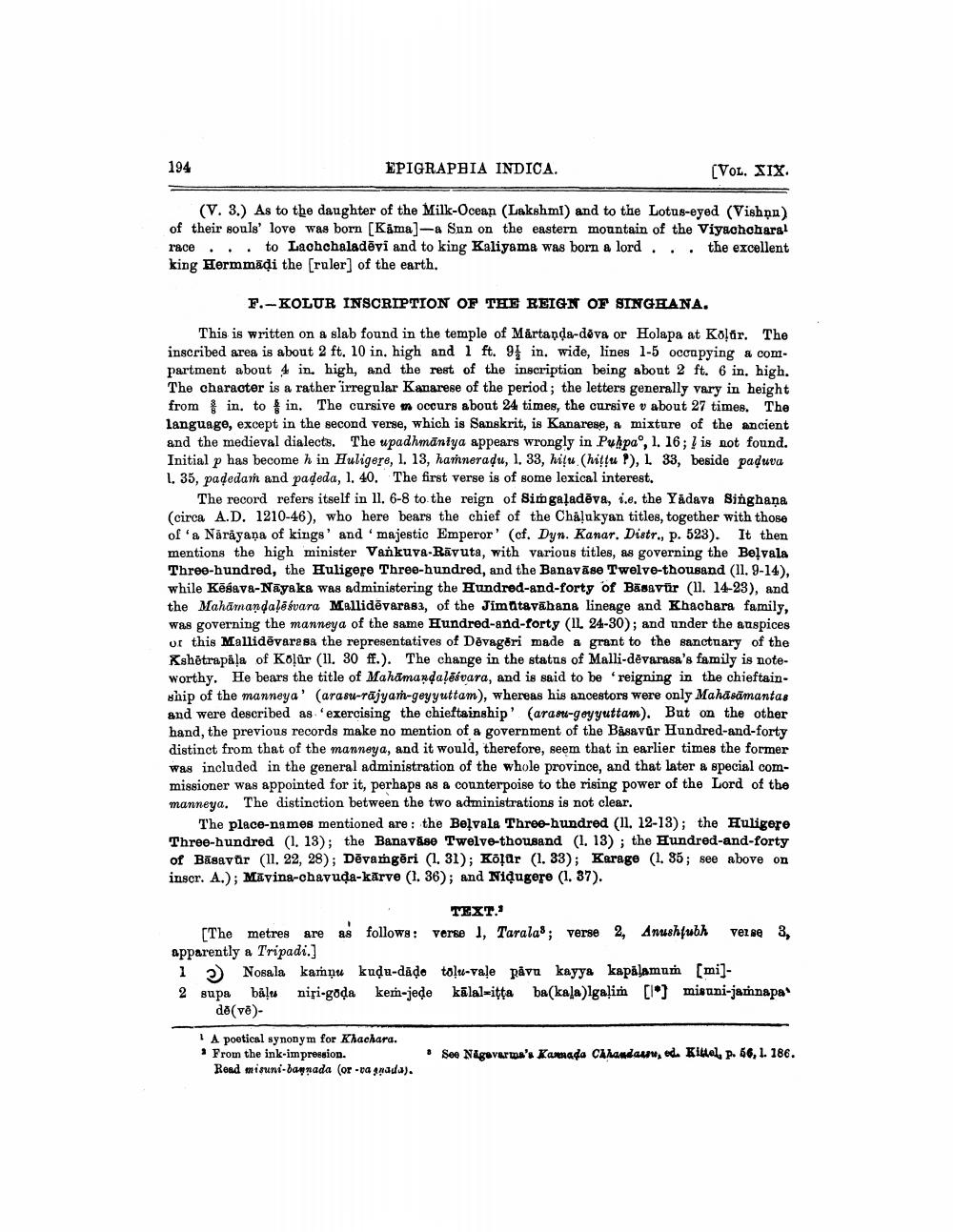________________
194
EPIGRAPHIA INDICA.
(VOL. XIX
(V. 3.) As to the daughter of the Milk-Ocean (Lakshmi) and to the Lotus-eyed (Vishạn) of their souls' love was born (Kama]-a Sun on the eastern mountain of the Viyachchara! race..to Lachchaladēvi and to king Kaliyama was born a lord... the excellent king Hermmadi the [ruler] of the earth,
F.-KOLUR INSCRIPTION OF THE REIGN OF SINGHANA.
This is written on a slab found in the temple of Mártanda-dova or Holapa at Kolar. The inscribed area is about 2 ft, 10 in. high and 1 ft. 9 in. wide, lines 1-5 occapying a compartment about 4 in. high, and the rest of the inscription being about 2 ft. 6 in, high. The character is a rather irregular Kanarese of the period; the letters generally vary in height from in. to in. The cursive m occurs about 24 times, the cursive v about 27 times. The language, except in the second verse, which is Sanskrit, is Kanarese, a mixture of the ancient and the medieval dialects. The upadhmāniya appears wrongly in Pulpa, 1. 16; ! is not found. Initial p has become h in Huligere, 1. 13, hamneradu, 1, 33, hiţu (hittu), L 33, beside paduva 1, 35, padedam and padeda, 1. 40. The first verse is of some loxical interest.
The record refers itself in 11. 6-8 to the reign of Sim galadēva, i.e. the Yadava Singhaņa (circa A.D. 1210-46), who here bears the chief of the Chalukyan titles, together with those of a Nārāyaṇa of kings' and 'majestic Emperor' (cf. Dyn. Kanar. Distr., p. 523). It then mentions the high minister Vankuva-Rāvuta, with various titles, as governing the Belvala Three-hundred, the Huligere Three-hundred, and the Banavise Twelve-thousand (11. 9-14), while Kēšava-Nāyaka was administering the Hundred-and-forty of Bāsavür (11. 14-23), and the Mahamandalesvara Mallidēvaras3, of the Jimatavāhana lineage and Khachara family, was governing the manneya of the same Hundred-and-forty (IL 24-30); and under the auspices or this Mallidēvare sa the representatives of Dēvageri made a grant to the sanctuary of the Kshētrapala of Koļür (11. 30 ff.). The change in the status of Malli-devarasa's family is noteworthy. He bears the title of Mahamandalesvara, and is said to be reigning in the chieftainship of the manneya' (arasu-rājyar-geyyuttam), whereas his ancestors were only Mahāsāmantas and were described as exercising the chieftainship' (aras-geyyuttam). But on the other hand, the previous records make no mention of a government of the Basavür Hundred-and-forty distinct from that of the manneya, and it would, therefore, seem that in earlier times the former was included in the general administration of the whole province, and that later a special commissioner was appointed for it, perhaps as a counterpoise to the rising power of the Lord of the manneya. The distinction between the two administrations is not clear.
The place-ngmes mentioned are: the Beļvala Three-hundred (11. 12-13); the Huligere Three-hundred (1. 13); the Banavāse Twelve-thousand (1. 13); the Hundred-and-forty of Bagavür (11. 22, 28); Dēvamgēri (1, 31); Kõlar (1. 33); Karage (1.35; see above on inscr. A.); Māvina-chavuça-kārve (1. 36); and Nidugere (1. 37).
TEXT. The metres are as follows: verse 1, Taralas; verse 2, Anushfubh Verde 3, apparently a Tripadi.] i Nosala kamņu kudu-dāņo toļu-vale påvu kayya kapälamun [mi]2 gupa bālu niri-goda kern-jede kālal=itta ba(kala)lgaļim [19] misuni-jamnapa
dē(vē)
! A poetical synonym for Khachara. : From the ink-impression.
Read misuni-bannada (or-vanada).
• See Nagavarma's Kannada Canandauw, ed. Kital, p. 66, 1. 186.




